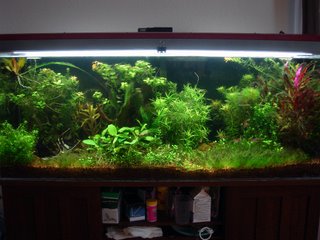Pinker Rotala indica
- pH:
- Temp:
- KH:
- GH:
- NH4:
- NO2:
- NO3:
- PO4:
- Iron:
- Dosing: 5 mL Flourish, 25 mL Excel (+15 mL at night), 5 mL iron chelate
- NO3:PO4 Cumulative Dosing Ratio:
Notes:
All the angelfish eggs have died, so I removed them. I don't know why. Perhaps the water was too hard (estimate GH approx 15) for the eggs to be fertilized properly, or perhaps the Excel adversely affected the eggs.
 A few of the Rotala indica stems have been growing in nice and pink. I still don't know what makes these plants redder: more Calcium? More micros? Less iron?
A few of the Rotala indica stems have been growing in nice and pink. I still don't know what makes these plants redder: more Calcium? More micros? Less iron?The algae is still dying away. Excel seems to be very effective against staghorn, BGA and green beard algae, and to a certain extent, green dust algae. The growth of the green dust algae has decreased by about half. It doesn't seem effective against the dark green hair algae, though. I've noticed more of the hair algae since the other algae types have decreased.
Otherwise, although the stargrass has been growing great, the other plants (esp. L. repens, R. indica) have still been growing in stunted. I'll probably try upping the Calcium again after the next water change.















